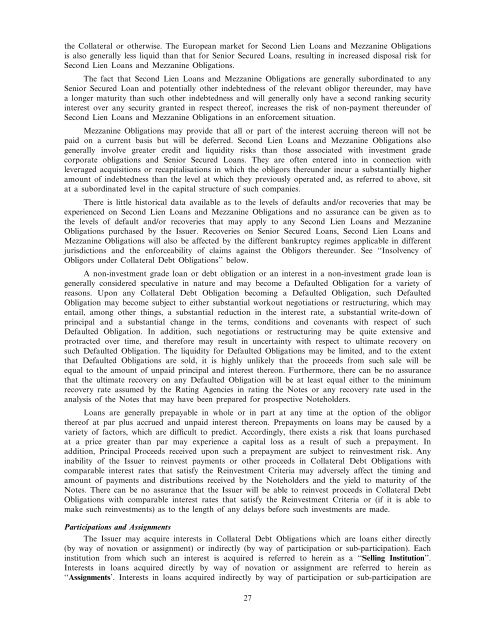VALLAURIS II CLO PLC - Irish Stock Exchange
VALLAURIS II CLO PLC - Irish Stock Exchange
VALLAURIS II CLO PLC - Irish Stock Exchange
You also want an ePaper? Increase the reach of your titles
YUMPU automatically turns print PDFs into web optimized ePapers that Google loves.
the Collateral or otherwise. The European market for Second Lien Loans and Mezzanine Obligations<br />
is also generally less liquid than that for Senior Secured Loans, resulting in increased disposal risk for<br />
Second Lien Loans and Mezzanine Obligations.<br />
The fact that Second Lien Loans and Mezzanine Obligations are generally subordinated to any<br />
Senior Secured Loan and potentially other indebtedness of the relevant obligor thereunder, may have<br />
a longer maturity than such other indebtedness and will generally only have a second ranking security<br />
interest over any security granted in respect thereof, increases the risk of non-payment thereunder of<br />
Second Lien Loans and Mezzanine Obligations in an enforcement situation.<br />
Mezzanine Obligations may provide that all or part of the interest accruing thereon will not be<br />
paid on a current basis but will be deferred. Second Lien Loans and Mezzanine Obligations also<br />
generally involve greater credit and liquidity risks than those associated with investment grade<br />
corporate obligations and Senior Secured Loans. They are often entered into in connection with<br />
leveraged acquisitions or recapitalisations in which the obligors thereunder incur a substantially higher<br />
amount of indebtedness than the level at which they previously operated and, as referred to above, sit<br />
at a subordinated level in the capital structure of such companies.<br />
There is little historical data available as to the levels of defaults and/or recoveries that may be<br />
experienced on Second Lien Loans and Mezzanine Obligations and no assurance can be given as to<br />
the levels of default and/or recoveries that may apply to any Second Lien Loans and Mezzanine<br />
Obligations purchased by the Issuer. Recoveries on Senior Secured Loans, Second Lien Loans and<br />
Mezzanine Obligations will also be affected by the different bankruptcy regimes applicable in different<br />
jurisdictions and the enforceability of claims against the Obligors thereunder. See ‘‘Insolvency of<br />
Obligors under Collateral Debt Obligations’’ below.<br />
A non-investment grade loan or debt obligation or an interest in a non-investment grade loan is<br />
generally considered speculative in nature and may become a Defaulted Obligation for a variety of<br />
reasons. Upon any Collateral Debt Obligation becoming a Defaulted Obligation, such Defaulted<br />
Obligation may become subject to either substantial workout negotiations or restructuring, which may<br />
entail, among other things, a substantial reduction in the interest rate, a substantial write-down of<br />
principal and a substantial change in the terms, conditions and covenants with respect of such<br />
Defaulted Obligation. In addition, such negotiations or restructuring may be quite extensive and<br />
protracted over time, and therefore may result in uncertainty with respect to ultimate recovery on<br />
such Defaulted Obligation. The liquidity for Defaulted Obligations may be limited, and to the extent<br />
that Defaulted Obligations are sold, it is highly unlikely that the proceeds from such sale will be<br />
equal to the amount of unpaid principal and interest thereon. Furthermore, there can be no assurance<br />
that the ultimate recovery on any Defaulted Obligation will be at least equal either to the minimum<br />
recovery rate assumed by the Rating Agencies in rating the Notes or any recovery rate used in the<br />
analysis of the Notes that may have been prepared for prospective Noteholders.<br />
Loans are generally prepayable in whole or in part at any time at the option of the obligor<br />
thereof at par plus accrued and unpaid interest thereon. Prepayments on loans may be caused by a<br />
variety of factors, which are difficult to predict. Accordingly, there exists a risk that loans purchased<br />
at a price greater than par may experience a capital loss as a result of such a prepayment. In<br />
addition, Principal Proceeds received upon such a prepayment are subject to reinvestment risk. Any<br />
inability of the Issuer to reinvest payments or other proceeds in Collateral Debt Obligations with<br />
comparable interest rates that satisfy the Reinvestment Criteria may adversely affect the timing and<br />
amount of payments and distributions received by the Noteholders and the yield to maturity of the<br />
Notes. There can be no assurance that the Issuer will be able to reinvest proceeds in Collateral Debt<br />
Obligations with comparable interest rates that satisfy the Reinvestment Criteria or (if it is able to<br />
make such reinvestments) as to the length of any delays before such investments are made.<br />
Participations and Assignments<br />
The Issuer may acquire interests in Collateral Debt Obligations which are loans either directly<br />
(by way of novation or assignment) or indirectly (by way of participation or sub-participation). Each<br />
institution from which such an interest is acquired is referred to herein as a ‘‘Selling Institution’’.<br />
Interests in loans acquired directly by way of novation or assignment are referred to herein as<br />
‘‘Assignments’. Interests in loans acquired indirectly by way of participation or sub-participation are<br />
27

















